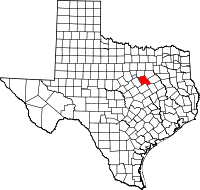Hubbard, Texas
| Hubbard, Texas | |
|---|---|
| City | |
|
| |
|
Location of Hubbard, Texas | |
 | |
| Coordinates: 31°50′51″N 96°47′50″W / 31.84750°N 96.79722°WCoordinates: 31°50′51″N 96°47′50″W / 31.84750°N 96.79722°W | |
| Country | United States |
| State | Texas |
| County | Hill |
| Area | |
| • Total | 2.0 sq mi (5.2 km2) |
| • Land | 2.0 sq mi (5.1 km2) |
| • Water | 0.0 sq mi (0.0 km2) |
| Elevation | 650 ft (198 m) |
| Population (2000) | |
| • Total | 1,586 |
| • Density | 800.8/sq mi (309.2/km2) |
| Time zone | Central (CST) (UTC-6) |
| • Summer (DST) | CDT (UTC-5) |
| ZIP code | 76648 |
| Area code(s) | 254 |
| FIPS code | 48-35180[1] |
| GNIS feature ID | 1338201[2] |
Hubbard is a city located in Hill County in Central Texas. It was named for Texas Governor Richard B. Hubbard. This city is sixty-four miles south of Dallas. The population was 1,423 at the 2010 census.
History
Hubbard is the second largest community in Hill County. It was named after Richard B. Hubbard, who was the 16th Governor of Texas. He was on hand at the sales of the first town lots on August 11, 1881. Hubbard was organized when the railroads were built through this section of the state. Its first bank was organized in 1881. In 1895 mineral water was discovered in Hubbard. This spawned several bath houses and a sanitarium. Hubbard's reputation as a health resort contributed to its population increase.
Geography
Hubbard is located at 31°50′51″N 96°47′50″W / 31.84750°N 96.79722°W (31.847593, -96.797352).[3]
According to the United States Census Bureau, the city has a total area of 2.0 square miles (5.2 km2), of which, 2.0 square miles (5.2 km2) of it is land and 0.50% is water.
Demographics
| Historical population | |||
|---|---|---|---|
| Census | Pop. | %± | |
| 1890 | 894 | — | |
| 1900 | 1,608 | 79.9% | |
| 1910 | 1,843 | 14.6% | |
| 1920 | 2,072 | 12.4% | |
| 1930 | 1,855 | −10.5% | |
| 1940 | 1,871 | 0.9% | |
| 1950 | 1,768 | −5.5% | |
| 1960 | 1,628 | −7.9% | |
| 1970 | 1,572 | −3.4% | |
| 1980 | 1,676 | 6.6% | |
| 1990 | 1,589 | −5.2% | |
| 2000 | 1,586 | −0.2% | |
| 2010 | 1,423 | −10.3% | |
| Est. 2015 | 1,370 | [4] | −3.7% |
As of the census[1] of 2000, there were 1,586 people, 625 households, and 406 families residing in the city. The population density was 800.8 people per square mile (309.3/km²). There were 715 housing units at an average density of 361.0/sq mi (139.4/km²). The racial makeup of the city was 74.46% White, 20.81% African American, 0.25% Native American, 0.19% Asian, 1.39% from other races, and 2.90% from two or more races. Hispanic or Latino of any race were 3.97% of the population.
There were 625 households out of which 30.9% had children under the age of 18 living with them, 44.6% were married couples living together, 17.1% had a female householder with no husband present, and 35.0% were non-families. 32.0% of all households were made up of individuals and 20.0% had someone living alone who was 65 years of age or older. The average household size was 2.42 and the average family size was 3.10.
In the city the population was spread out with 27.5% under the age of 18, 6.8% from 18 to 24, 24.0% from 25 to 44, 19.9% from 45 to 64, and 21.9% who were 65 years of age or older. The median age was 39 years. For every 100 females there were 78.4 males. For every 100 females age 18 and over, there were 73.7 males.
The median income for a household in the city was $25,950, and the median income for a family was $34,083. Males had a median income of $30,795 versus $16,696 for females. The per capita income for the city was $15,311. About 20.4% of families and 24.5% of the population were below the poverty line, including 36.7% of those under age 18 and 15.1% of those age 65 or over.
Education
The City of Hubbard is served by the Hubbard Independent School District.
Notable residents
- Mark English, illustrator and painter
- Samuel D. Johnson, Jr., United States federal judge
- J. Frank Norris, fundamentalist Baptist pastor
- Ron Shanklin, NFL player
- Tris Speaker, baseball Hall of Famer
References
- 1 2 "American FactFinder". United States Census Bureau. Retrieved 2008-01-31.
- ↑ "US Board on Geographic Names". United States Geological Survey. 2007-10-25. Retrieved 2008-01-31.
- ↑ "US Gazetteer files: 2010, 2000, and 1990". United States Census Bureau. 2011-02-12. Retrieved 2011-04-23.
- ↑ "Annual Estimates of the Resident Population for Incorporated Places: April 1, 2010 to July 1, 2015". Retrieved July 2, 2016.
- ↑ "Census of Population and Housing". Census.gov. Retrieved June 4, 2015.
